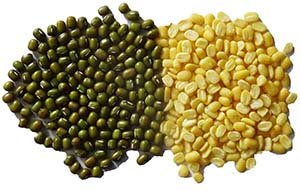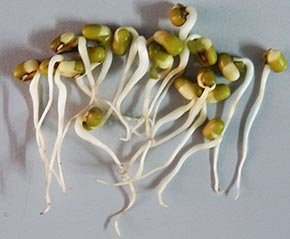Mung Bean Nutrition facts
Mung beans, originating from India, are small, green to olive-green color seeds classified within the legume family of plants. In the USA and Western countries, they are primarily recognized for their crisp and nutritious bean sprouts.
Botanically, they are a part of the Fabaceae family, specifically in the Genus Vigna. Scientific name: Vigna radiata..
 |
| Mung beans, whole and split. |
The mung bean plant is an annual, branching dicotyledonous species that typically reaches heights of 60 to 75 cm. Known for its resilience, it thrives in hot and dry conditions.
Clusters of pale yellow flowers give way to slender cylindrical pods, measuring 6 to 10 cm in length, each containing 10 to 15 seeds. These seeds exhibit a wide range of variations upon maturity, ranging from shiny green to light green, deep green, dull green, greenish-yellow, and occasionally black-mottled.
Free from glycosides, the seeds are edible both raw and when sprouted. When boiled, they soften in texture and develop a subtly sweet taste.
 |
| Mung beans, sprouted. |
Harvesting should occur once pods have reached maturity and dried, but prior to the onset of shattering.
Health Benefits of Mung Beans
Mung beans are legumes that are moderately caloric, rich in protein, low in fat, and free of cholesterol.
Unlike other beans and pulses, they contain very few anti-nutrient compounds and lack glycosides.
A 100-gram serving of dry mung beans contains 347 calories and provides 23.86 grams, or 43% of the recommended daily value of protein.
Whole mung beans are notably high in dietary fiber, offering 16.3 grams, or 43% of the recommended intake, per 100 grams. Dietary fiber acts as a bulk laxative, protecting the colon mucosa by reducing exposure time to toxic substances and binding to potential cancer-causing chemicals.
Dietary fiber has been demonstrated to lower blood cholesterol levels by reducing the reabsorption of cholesterol-binding bile acids in the colon.
Mung beans are gluten-free and are preferred as alternatives for individuals with gluten allergies or celiac disease.
Both whole mung beans and sprouts are rich in B-complex vitamins, particularly folates, thiamin, pyridoxine, pantothenic acid, riboflavin, and niacin. These vitamins act as co-factors for enzymes involved in carbohydrate, protein, and fat metabolism.
A serving of whole dry mung beans provides 625 µg, or 156% of the daily required value of folate. Folate, along with vitamin B-12, is essential for DNA synthesis and cell division. Sufficient folate intake before and during pregnancy may help prevent neural tube defects in infants.
While dry mung beans contain 4.8 mg, or 8% of the Daily Value (DV) of vitamin C, sprouts contain significantly higher amounts of this vitamin.
Vitamin C is a water-soluble antioxidant that supports immune function and combats oxygen-induced free radicals in the body.
Mung beans are also rich in essential minerals. A 100-gram serving of dry mung beans contains 104.5% of the DV for copper, 84% for iron, 45% for manganese, 52% for phosphorus, 15% for selenium, 13% for calcium, and 24% for zinc.
Both copper and iron are involved in the production of blood cells in the body.
Furthermore, mung beans are excellent sources of potassium. A 100-gram serving provides 1246 mg, or 26.5% of the DV. Potassium, found in cells and body fluids, counteracts the effects of sodium on the heart, helping to reduce blood pressure.
| Principle | Nutrient Value | Percent of RDA |
|---|---|---|
| Energy | 347 Kcal | 17% |
| Carbohydrates | 62.62 g | 48% |
| Protein | 23.86 g | 43% |
| Total Fat | 1.15 g | 6% |
| Cholesterol | 0 mg | 0% |
| Dietary Fiber | 16.3 g | 43% |
| Vitamins | ||
| Folates | 625 μg | 156% |
| Niacin | 2.251 mg | 16% |
| Pyridoxine | 0.382 mg | 29% |
| Riboflavin | 0.233 mg | 18% |
| Thiamin | 0.621 mg | 52% |
| Vitamin-A | 114 IU | 4% |
| Vitamin-C | 4.8 mg | 8% |
| Electrolytes | ||
| Sodium | 15 mg | 1% |
| Potassium | 1246 mg | 26.5% |
| Minerals | ||
| Calcium | 132 mg | 13% |
| Copper | 0.941 μg | 104.5% |
| Iron | 6.74 mg | 84% |
| Magnesium | 189 mg | 47% |
| Manganese | 1.035 mg | 45% |
| Phosphorus | 367 mg | 52% |
| Selenium | 8.2 μg | 15% |
| Zinc | 2.68 mg | 24% |
| Phyto-nutrients | ||
| Carotene-β | 68 μg |
Selection and storage
Fresh dry mung seeds are readily available in retail shops throughout the year. When selecting mung beans in-store, seek for dry seeds packed in bins or bags. Whole, split, or yellow (split and hulled) beans may also be available for purchase. Avoid selecting beans that show signs of insect damage, breakage, shriveling, or discoloration, as these are indicators of inferior quality.
Mung bean sprouts are typically sold in plastic trays or bags. To extend their shelf life, store the sprouts in a plastic bag with a few drops of water, seal it, and place them in the refrigerator. When stored this way, they can last for up to two days.
For home storage, place whole dry beans in plastic or steel containers, ensuring they are kept away from moisture and heat. When stored in air-tight bins, whole mung beans can maintain their quality for several months.
Preparation and Serving methods
In many Asian households, mung beans are a dietary staple, offering a nutritional advantage over other legumes due to their lower levels of anti-nutrients. This makes them gentler on the digestive system, and they are even suitable for inclusion in infant formulas as a protein source.
To prepare, soak whole dry beans in water for 1-2 hours. While soaking isn't obligatory, it speeds up the cooking process, reduces anti-nutrient content, and enhances flavor.
Cook under pressure for 10 minutes after soaking, or 15-20 minutes without soaking, being careful not to overcook.
Here are some serving tips:
Mungbean and its sprouts are commonly utilized in cuisine across China, India, Japan, Korea, and Southeast Asian countries such as Thailand, Vietnam, and Indonesia.
In the USA, mung beans are primarily recognized for their role as sprouts, integral to dishes like chop suey, salads, and various Asian-style stir-fries.
Mung beans are versatile legumes, akin to others in their category, and find application in numerous traditional Indian dhal recipes alongside seasonal vegetables, herbs, and spices.
Across India and Pakistan, mung dal ka halwa (मूंग दाल का हलवा) stands out as a sweet dessert crafted from yellow split (hulled) mung beans, often enhanced with nuts and dried fruits.
In Maharashtra, the breakfast specialty mung bean usal combines sprouted beans with onion, tomato, and seasonings.
Yellow-split mung dal stuffed bread, known as mung bean parantha, enjoys popularity in Punjab province, India.
In Japan, China, and various Southeast Asian regions, mung bean sprouts are frequently incorporated into stir-fries and used as a garnish for dishes.
Immature mung pods can be prepared and cooked similarly to green beans.
Safety Profile
Mung beans are highly digestible legumes, seldom causing flatulence issues. Due to this quality, they serve as a valuable protein source in infant formulas. (Medical disclaimer).
You may also like to read≻≻-
≻≻-Mung bean sprouts nutrition facts and health benefits.
≻≻- Adzuki beans Nutrition facts and health benefits.
≻≻- Black gram Nutrition facts and health benefits.
≻≻- Chickpeas Nutrition facts and health benefits.
≻≻- Navy beans Nutrition facts and health benefits.
≻≻-Back to Legumes from Mung bean nutrition. Visit here for an impressive list of vegetables with complete illustrations of their nutrition facts and health benefits.
≻≻-Back to Home page.
Further Reading:
Sprouted seeds safety advice- NHS.
Mung beans Crop Guide -pdf.